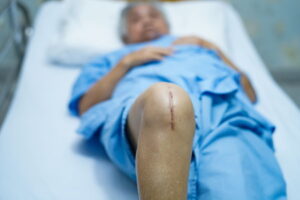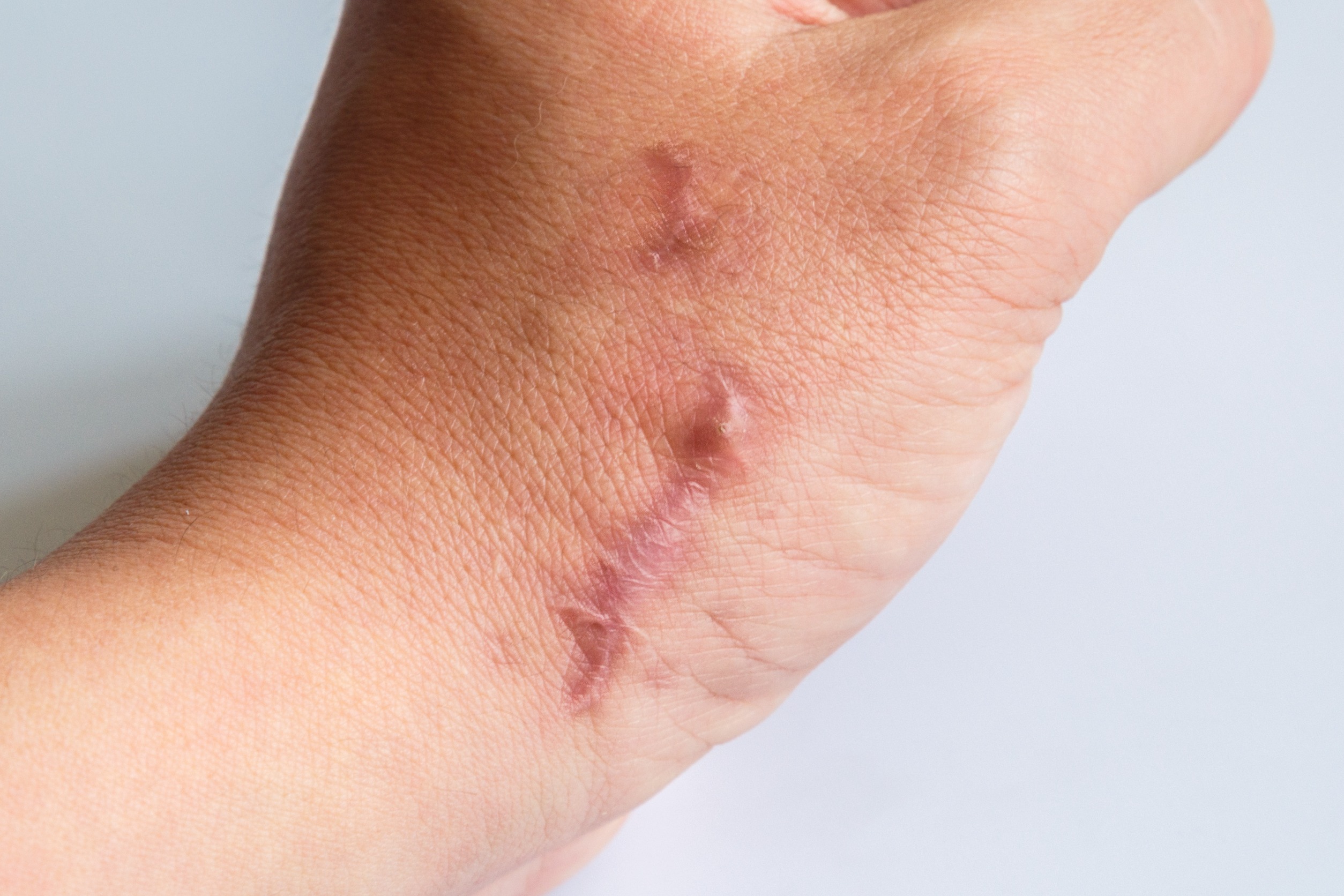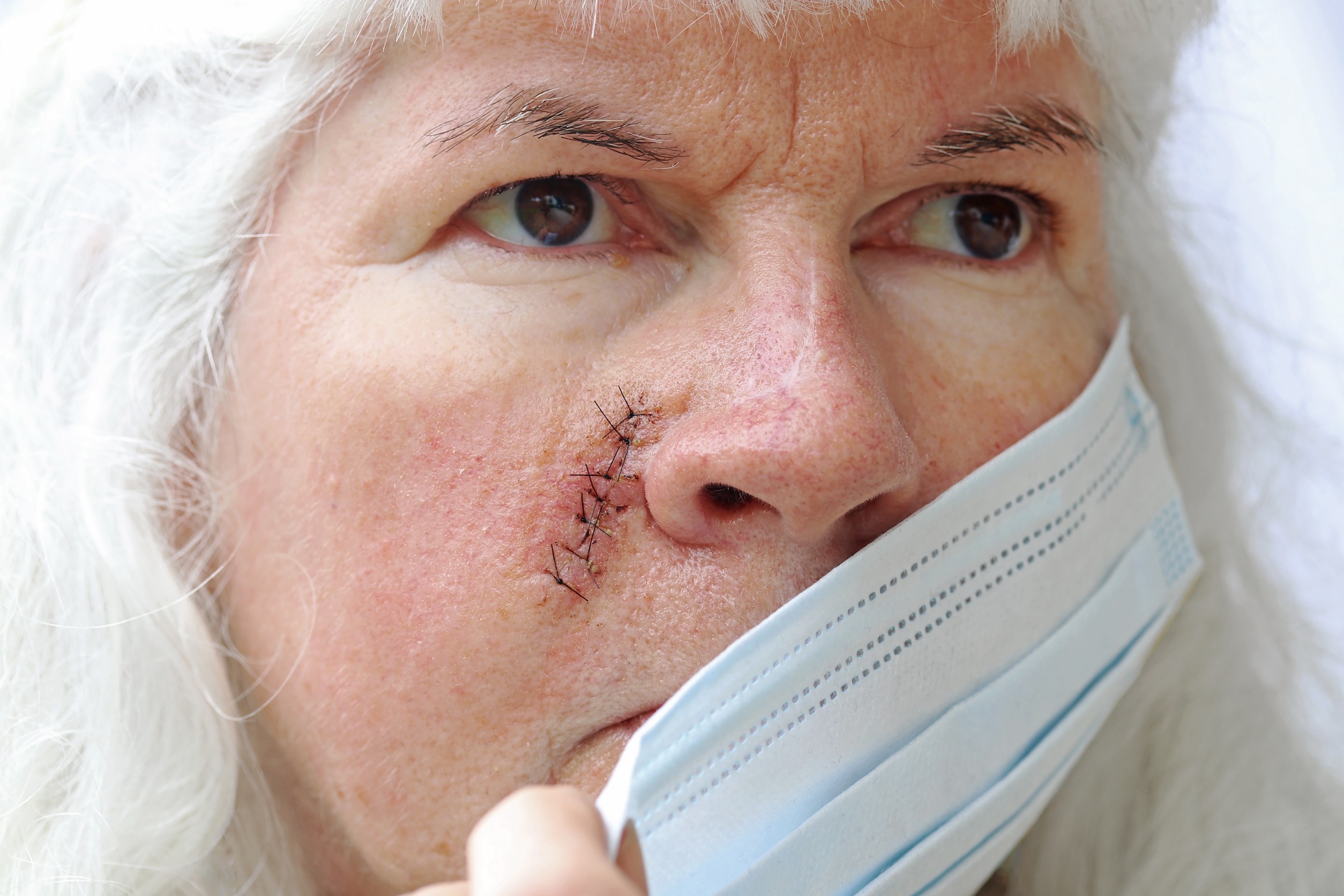By Danielle Graves. Last Updated 12th January 2024. If you’re asking ‘how much compensation can I claim per stitch in the UK?’, the likelihood is you have an injury that requires stitches. But is this the right question to ask to get an idea of how much your injury could be worth?
If you sustain a laceration injury in an accident that wasn’t your fault, you may be considering claiming compensation. But, like some claimants, you may wish to get an idea of how much compensation you could receive before you go ahead. This is understandable, and this is why we have put together this guide.

How much compensation per stitch could you be awarded?
In this guide, we show in what situations you might need stitches, and how they could cause a temporary or even a permanent scar. We then answer some common questions about the average compensation for a soft tissue injury in the UK. In addition, we explain why a soft tissue injury compensation calculator in the UK might not be the best way to get an idea of how much your claim could be worth.
As well as this, we offer some pain and suffering settlement examples for UK cases involving scarring, and explain how you could start a claim without paying solicitor fees upfront. We hope you find this guide useful. If you are ready to claim compensation for scarring, or you have further questions, you can reach our expert advisors on 0161 696 9685.
Jump To A Section
- What Injuries Need Stitches?
- Causes Of Lacerations Which Lead To Scarring
- Evidence You’ll Need To Claim For Your Injuries
- Compensation For Permanent Scarring
- What Special Damages Could I Claim For An Injury That Needs Stitches?
- No Win No Fee Compensation For Injuries That Need Stitches
- Useful Links
What Injuries Need Stitches?
Whether you’re injured in a car accident that wasn’t your fault, or you sustain injuries in a slip or trip incident due to someone’s negligence, you might have to have stitches to close up a wound. There are various injuries that may require stitches, such as:
Getting the right treatment for cuts and lacerations is vital in helping you have the best chance of recovery. Complications from cuts and lacerations could include:
- Amputations
- Nerve/muscle damage
- Infections
- Tissue damage
- Skin grafts
Sometimes, the more complex the laceration, the more likely it is that your injury could leave you with a scar. If you sustain scarring from an accident that wasn’t your fault, you could claim personal injury compensation for the suffering and pain you experience as a result. You could also claim compensation for the emotional and financial effects of such an injury.
Causes Of Lacerations Which Lead To Scarring
There are various incidents that can cause a laceration injury. These include road traffic accidents, public place incidents and accidents at work.
Some examples of incidents that could result in scarring include:
- A slip, trip and fall on a wet floor. This could cause a fractured bone that may need surgery leaving behind scarring.
- Cuts from shattered glass, such as in a car accident. These can cause lacerations that leave behind facial scars.
- An object may fall from a height and shatter causing cuts. For example, an accident in a shop may be caused by poorly stacked glass jars falling onto a member of the public or an employee.
- Sharp objects may cut a passenger in a bus accident. For example, if seat is faulty, and has sharp edges, it could cause a laceration to a passenger’s leg when they sit down.
However, in order to have a valid claim for stitches, you must meet the eligibility requirements. You must be able to prove that:
- You were owed a duty of care.
- This duty was breached.
- You suffered an injury as a result of the breach.
A duty of care could be owed to you in each of the situations above, but who owes it will be different. For example, employers owe a duty of care at work, road users owe a duty to one another, and occupiers owe a duty to those using a public space.
There is legislation that each one of these parties needs to adhere to. If this legislation is not adhered to, and you experience harm as a result, get in touch with our team to find out if you could make a personal injury claim. They can also discuss the different pieces of legislation that outline the duty of care owed to you.
Evidence You’ll Need To Claim For Your Injuries
You need to be able to prove that the scar you’ve sustained is the result of a breach of duty of care that was owed to you. This can be achieved by gathering evidence to support your claim. Each claim will be different, and therefore different evidence will likely work best depending on your circumstances.
Here are some examples:
- Photographs
- Video footage of the accident (CCTV, dashcam etc.)
- Medical records
- Witness statements
To find out more, reach out today. We can also give you a valuation of how much you could receive in compensation for a scar, including facial scarring compensation. Our advisors can give you advice on claiming compensation for a scar on your face.
Compensation For Permanent Scarring
As previously discussed, a lot of different factors determine awards in personal injury claims. For example, compensation for permanent scarring may include special damages. As such, we cannot provide the average settlement for scarring. Special damages is discussed in more detail in the next section.
In a compensation for permanent scarring claim, you’ll be compensated for the pain and suffering caused. You could also potentially claim for multiple issues. For example, if your scar was caused by a deep laceration wound, you could claim for the pain caused by this as well as for the scarring. This is under general damages.
The table below includes figures for compensation for permanent scarring from the Judicial College Guidelines (JCG), last updated in April 2022. Legal professionals use this document to help value claims, but the figures shown are not guaranteed as every case is different. Please note: the top row is not from the JCG. We’ve included it to show how compensation may be awarded for multiple serious injuries and incurred expenses.
| Injury | Severity/Notes | Compensation Bracket |
|---|---|---|
| Multiple serious injuries and special damages | Payouts could include compensation for multiple very severe injuries and expenses including lost wages and cosmetic surgery. | Up to £250,000+ |
| Facial disfigurements | (a)Very severe scarring. Usually in young people (teens to early thirties). The cosmetic impact would be very disfiguring and there would be a severe psychological reaction. | £29,780 to £97,330 |
| Facial disfigurements | (b)Less severe scarring. There would still be a substantial disfigurement and the psychological reaction would be significant. | £17,960 to £48,420 |
| Facial disfigurements | (c)Significant scarring. The worst effects would have been or would be reduced via plastic surgery. However, there would be still some remaining cosmetic disability. Psychological reaction wouldn’t be great or would have diminished over time. | £9,110 to £30,090 |
| Facial disfigurements | Less significant (d) There might be one scar or many little scars that mar the appearance. | £3,950 to £13,740 |
| Scarring to other parts of the body | Where there are a number of noticeable scars from lacerations, or one single scar that is disfiguring. On the legs, chest, arms, hands or back. | £7,830 to £22,730 |
| Scarring to other parts of the body | Scarring from a laparotomy where there was no significant internal injury. | In the region of £8,640 |
Call our advisors for a free estimation of your potential compensation for permanent scarring.
What Special Damages Could I Claim For An Injury That Needs Stitches?
As well as wanting to know how much compensation you get per stitch, you may be interested to learn that there are other damages you can claim, as well as damages for your pain and suffering. These are known as special damages. They relate to the pecuniary (financial) costs you experience as a result of your injuries.
They could include, but aren’t necessarily limited to:
- Travel Expenses
- Medical Costs
- Costs of Care
- Loss of Earnings
It is crucial to be able to evidence any special damages you are claiming for. You might want to keep any documentary evidence, such as payslips, bank statements and receipts in a safe place. This way, you could provide them to your lawyer at the appropriate time, ensuring you claim everything you are eligible for.
Claim Time Limits
When addressing the matter of how much you could be awarded in compensation per stitch in the UK, it’s important to remember that there are certain time limits that must be observed. The Limitation Act 1980 tells us that this time limit is generally 3 years from the date of the accident that caused your injuries. The time limit might also start from the date you gained knowledge of someone else causing or contributing to the injuries you sustained.
However, this time limit could be suspended in cases involving children, or those with a reduced mental capacity.
For child injury cases, their time limit would only begin once they turn 18, as they cannot pursue their own claim until this date. However, this is only if someone hasn’t already claimed on their behalf.
For cases involving those with a reduced mental capacity, their time limit would only begin in the event that their mental capacity were to reach a point they are deemed capable of claiming by themselves. Otherwise, it remains suspended.
In both of these examples, it may be possible to appoint a litigation friend to claim on behalf of a claimant who is not legally permitted to for any of the above reasons.
No Win No Fee Compensation For Injuries That Need Stitches
If you meet the eligibility criteria to make a claim for permanent scar compensation, you may like to have a solicitor to help you during the claims process.
Our panel of solicitors offer their legal services on a No Win No Fee basis under a Conditional Fee Agreement (CFA). When your solicitor represents your claim on a No Win No Fee basis, they won’t take upfront fees to cover their services, and they also won’t take payment for their work if your claim does not succeed.
However, if your personal injury claim succeeds, they will take a success fee from your compensation. The amount that can be taken as this fee is a capped percentage limited by the law.
If you would like to discuss how much compensation per stitch in the UK, get in touch with a member of our advisory team. They can provide you with a free evaluation of your claim without any further obligation. This could include a free valuation of your potential personal injury compensation. If you are eligible, you could also be connected to one of the No Win No Fee solicitors from our panel. To speak to a member of the team:
- Call 0161 696 9685
- Complete the contact us form, and a team member will get back to you
- Or use the Live Chat feature
Useful Links
- Scar Massage – This NHS publication discusses whether scar massage could have an effect on the healing of scars.
- Lacerations – Here, you can read more about the NICE guidance on treating lacerations.
- Keloid Scars – You can read more about keloid scars here.
- Serious Injuries – Your stitches may be required due to a deeper-lying and possibly even life-altering injury. Find out more about how much your overall claim could be worth.
- Knife Crime Compensation – Here, we look at how to work out if you could claim for injuries you sustain due to knife crime.
- Negligence In Cosmetic Surgery – You can find out about compensation payouts for negligent surgery here.
We hope this guide answered the question, ‘how much compensation can I claim per stitch in the UK?’ for you.






